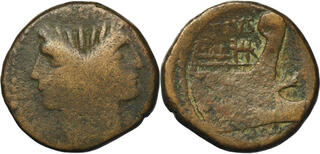Lot description:
Roman Republic, Sextus Pompeius, AE - RARE
Rare bronze minted in military mint in Sicily or Spain.
Roman Republic
Sextus Pompeius (40-39 BC), As 43-36 BC, military mint in Sicily or Spain
Obverse: laureate Janus head, above MGN
Reverse: prow to right, above PIVS, below IMP
Diameter 29 mm, weight 22.86 g
Offered coin was minted by the younger son of Pompey the Great (latin Pompeius Magnus), who took the nickname and republican beliefs from his father. When, in 42 BC, the allies in the second triumvirate, Octavian and Antony, defeated the army of Cassius and Brutus at Philippi, Sextus Pompey, who in 43 BC conquered Sicily, became the only enemy of the triumvirs. In 39 BC they made peace with him in Puteoli, giving him proconsular authority in Sicily, Sardinia, Corsica and the Peloponnese. However, after Marcus Agrippa's victory in the naval battle of Naulochos, Sextus's fleet was completely wiped out, and he was killed as a fugitive at Miletus.
Coins minted by Sextus Pompey most often commemorate his famous father or, as here, they bring sea motifs, because Sextus based his power almost exclusively on a strong fleet.
Rzadki brąz wybity w mennicy wojskowej na Sycylii lub w Hiszpanii.
Republika Rzymska
Sextus Pompeius (40–39 pne), As 43-36 pne, mennica wojskowa na Sycylii lub w Hiszpanii
Awers: głowa Janusa w wieńcu laurowym, powyżej MGN
Rewers: dziób statku w prawo, powyżej PIVS, poniżej IMP
Średnica 29 mm, waga 22.86 g
Oferowana moneta została wybita przez młodszego syna Pompejusza Wielkiego (łac. Pompeius Magnus), który przejął po ojcu przydomek oraz przekonania republikańskie. Gdy w 42 roku pne sprzymierzeni w drugim triumwiracie Oktawian i Antoniusz pokonali pod Filippi wojsko Kasjusza i Brutusa, Sekstus Pompejusz, który w 43 roku pne opanował Sycylię został jedynym wrogiem triumwirów. W 39 roku pne zawarli oni z nim pokój w Puteoli, oddając mu władzę prokonsularną na Sycylii, Sardynii, Korsyce i Peloponezie. Jednak po zwycięstwie Marka Agryppy w bitwie morskiej pod Naulochos flota Sekstusa została całkowicie rozbita, a on zabity jako zbieg w Milecie.
Monety bite przez Sekstusa Pompejusza najczęściej upamiętniają jego słynnego ojca albo jak tutaj, przynoszą motywy morskie, gdyż Sekstus opierał swą potęgę niemal wyłącznie na silnej flocie. Reference: Crawford 479/1, Sydenham 1044
Grade: F
Roman Republic Sextus Pompeius
Starting price: 8 EUR |  |